Using counting stats, it’s tempting to construct the narrative that Notre Dame’s massive win over USC was fluky. A 5-0 turnover margin, a special teams touchdown, more total yards for the Trojans and just 255 total yards for the Irish?
But as we dive into the numbers, it’s clear that Marcus Freeman’s team – the same one that looked exhausted and defeated at Louisville the previous week – outplayed Southern Cal in every phase of the game, with the turnovers and special teams magic the icing on the cake to build the large margin of victory. Notre Dame was more efficient, shockingly more explosive in the passing game, and wreaked havoc defensively in an Al Golden masterpiece.
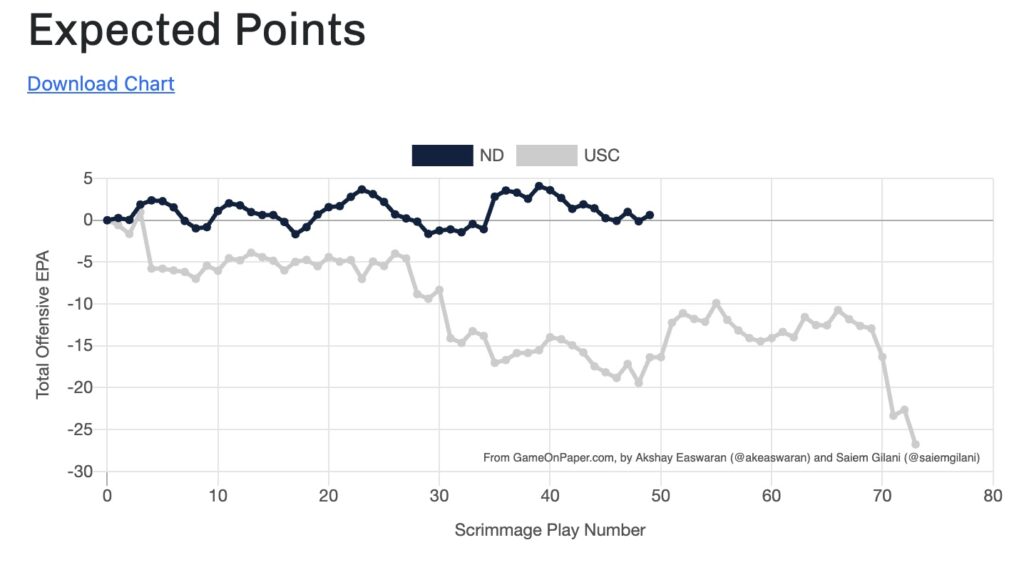
The Irish offense mostly tread water, capitalizing on scoring chances and in key moments while the ND defense consistently forced USC into negative plays that created separation.
There was just a sliver of garbage time in this game – USC and Notre Dame’s final drives (including kneel-downs) are excluded from the numbers below.
Stats from a few excellent sources – College Football Data, Game On Paper, and often referencing SP+ and FEI numbers. If you get lost, check out this handy advanced stats glossary here or reach out in the comments.
Al Golden, take a bow
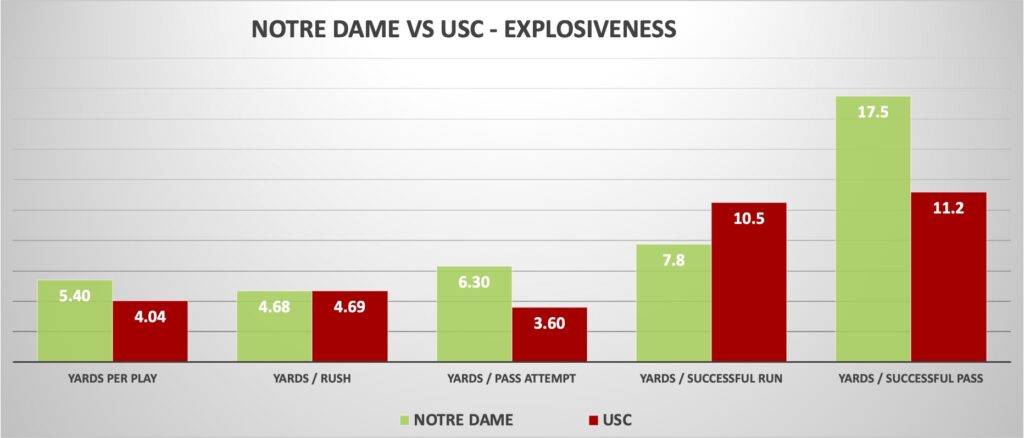
This Notre Dame secondary has been doing special things for most of the season, but there probably won’t be a performance as special as the USC game the rest of the way. Al Golden and the Irish defense ran circles around Lincoln Riley and Caleb Williams, forcing one of the nation’s best offenses to be extremely inefficient and struggle to create explosives. First down plays for the Trojans averaged just 1.9 yards, as the ND defense consistently wreaked havoc with negative plays. First down passing plays – a bread and butter opportunity in most games for SC – were dominated by the Irish, as the Trojans averaged just 0.68 yards per play, with success on 2 of 19 attempts (10.5%), and had two interceptions, three sacks, and a forced fumble. Special, special players showing out in a game where their dominance was sorely needed.
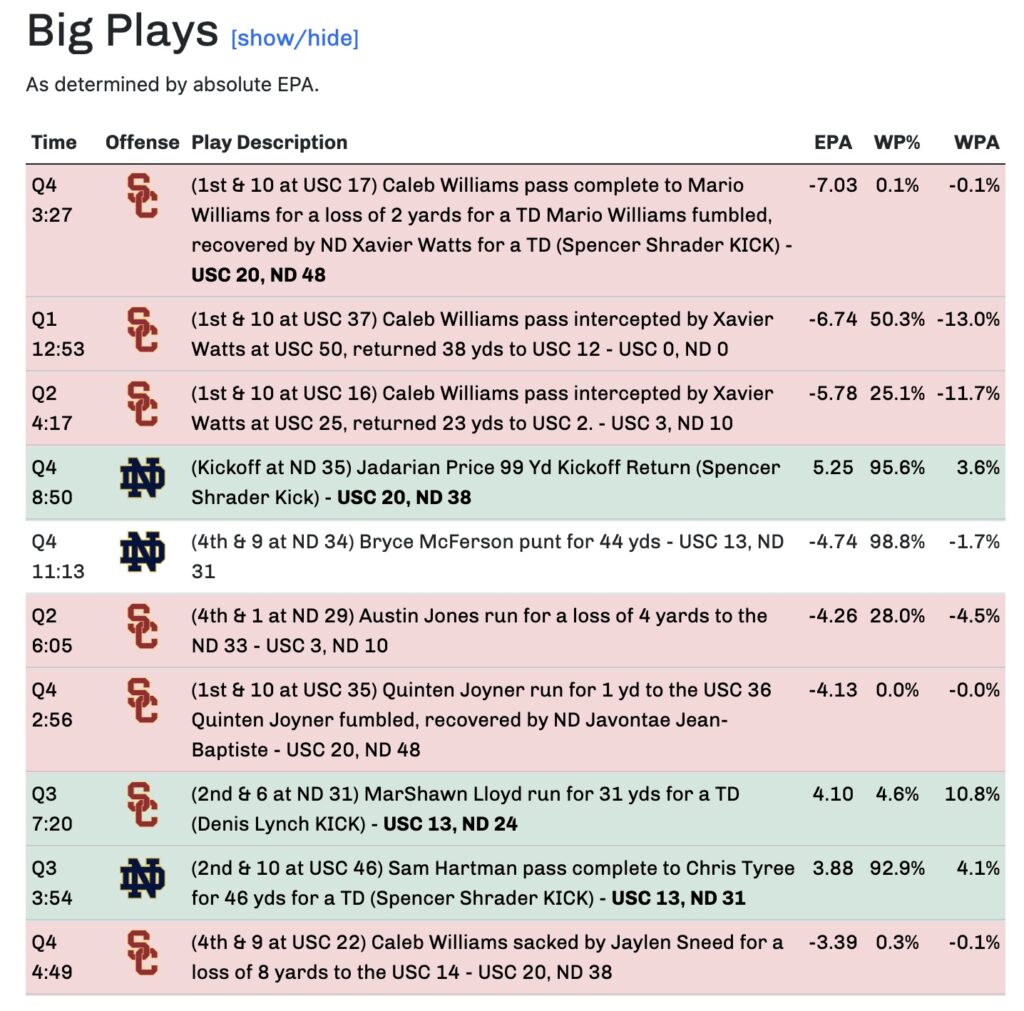
The Irish pulled off the insane defensive feat of single-handedly winning the explosiveness battle against a team that entered as the #1 offense in FBS per F+. Notre Dame shut down USC’s explosiveness – with virtually no long passes – and created the most impactful plays of the game with takeaways. Some may argue that this win will look worse as the Trojans continue to face stiffer competition – but I think this defensive effort will stand up over time regardless. Even in the loss to Utah – a top-10 defense per F+ – the Trojans averaged nearly 7 yards per play and a 47% success rate.
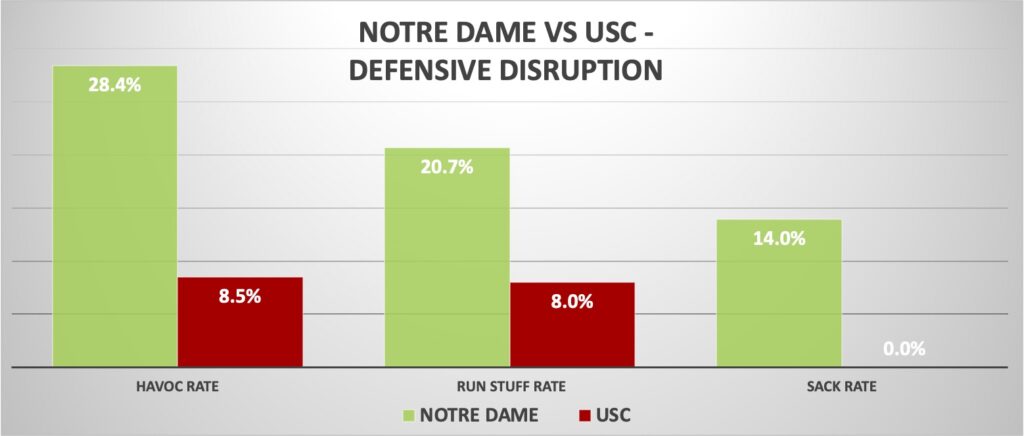
This was Notre Dame’s highest havoc rate against a P5 opponent since 2019 UVA, another game where the Irish pass rush and turnovers took over the game late. The first comparison that came to mind for me was one of my favorite reviews – 2018 Stanford, a game where a top-10 opponent from California came into Notre Dame Stadium and was absolutely exposed by a relentless Irish defense.

That 2018 game was dominated by Jerry Tillery (4 sacks, 1 forced fumble), and Xavier Watts game may have even exceeded that effort. If we get fancy with our numbers and use expected points added (EPA), X’s four big plays – two interceptions, a scoop-and-score for a touchdown, and another forced fumble – were worth roughly 22 points for Notre Dame. It was a legendary individual performance made possible by a terrific scheme and complete effort from every level of the defense.
The Irish offense is opportunistic, but still suffers dry spells in a “get-right” opportunity

Notre Dame’s offense wasn’t great against USC – pedestrian efficiency, struggles on passing downs, and some empty opportunities to stretch the lead while the defense stymied them. But the Irish were still more explosive through the air than USC, and converted scoring opportunities into touchdowns at a high rate. Still, it feels like a missed chance to right the ship against Alex Grinch’s leaky defense that wasn’t taken advantage of – the Irish gained a lower percentage of available yards per drive (40%) than they did in the struggles at Duke (46%).
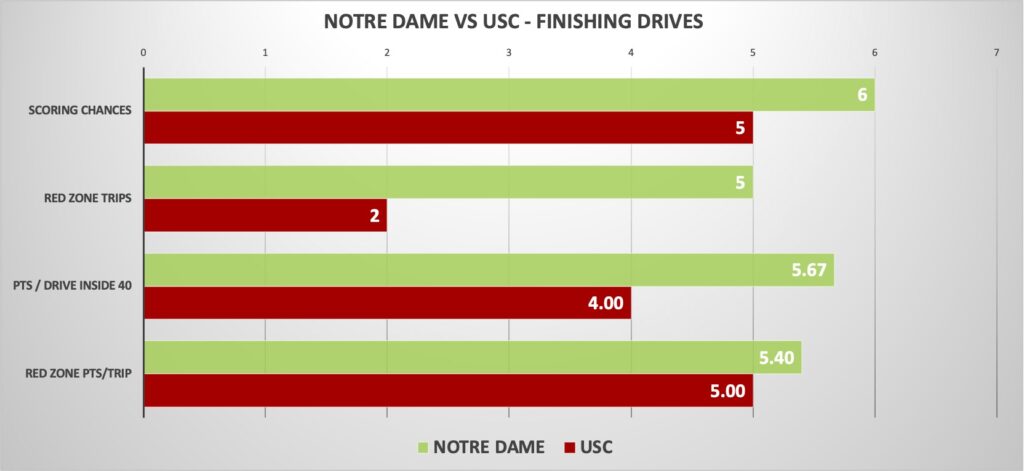 One saving grace was the return of an efficient rushing attack, even if it struggled to be explosive at just 4.7 yards per carry. The Irish avoided negative plays, with just two run stuffs on 25 run plays and continuing the streak of zero sacks allowed at home. The average 3rd down for Notre Dame was just 5.2 yards to gain. It was a low risk formula that worked with this kind of defensive effort.
One saving grace was the return of an efficient rushing attack, even if it struggled to be explosive at just 4.7 yards per carry. The Irish avoided negative plays, with just two run stuffs on 25 run plays and continuing the streak of zero sacks allowed at home. The average 3rd down for Notre Dame was just 5.2 yards to gain. It was a low risk formula that worked with this kind of defensive effort.
Still, just 14 of 20 Irish passes went for 5 yards or fewer (one of those was a successful play, converted the early touchdown on 3rd and 2 from the USC 4). Passing downs and third downs have been an immense struggle for the Irish over the past three games (18.8% on passing downs against Louisville, 24% at Duke). But there was the backbone of an efficient ground game and just enough explosive passes manufactured to make it work against USC (and, critically, avoiding negative plays and turnovers).
On to Pittsburgh
📊Opponent Adjusted EPA/play
Week 1-8◽️There is a Michigan/LinkedIn joke somewhere in here
◽️Part of me thinks that Iowa/Brian Ferentz is a bit
◽️Cal, UVA, GT, Purdue, Northwestern, Vanderbilt
◽️So w/ Bowers OUT & Wilson/Boardingham really just coming on for the Gators, I think pic.twitter.com/bd6lL855hL— Joshua “Bud” Davis, PhD (@JBudDavis) October 23, 2023
Notre Dame enters the final 1/3 of the season with a slightly disappointing record but performance quality in a strong place (hovering around top-10 quality). The Irish are currently 12th in F+ – 18th on offense, 8th on defense – which feels accurate for the totality of the season. With the defense firing on all cylinders and flashing terrific performances against Ohio State and USC, is a top-5 finish on the horizon?
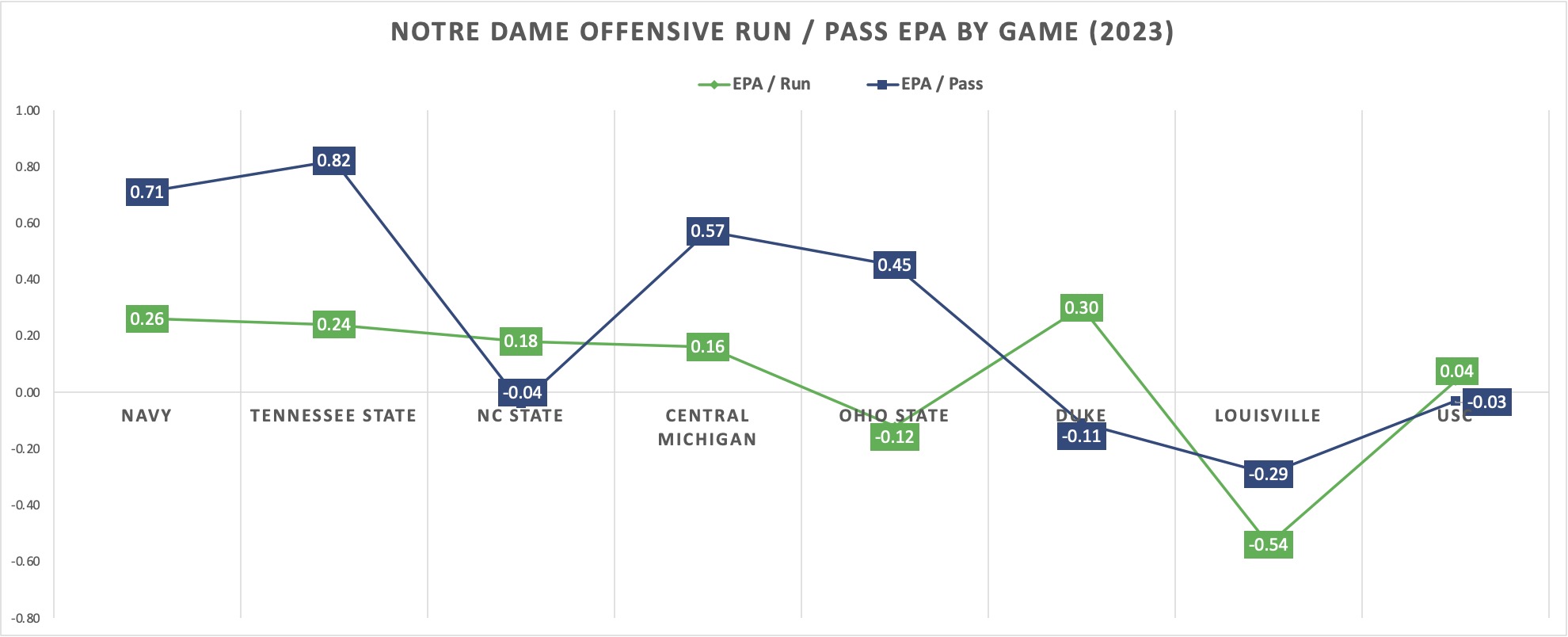
And critically for the final stretch, is the offense capable of returning to form after the bye, or will the depth and upside issues at wide receiver continue to hamper performance? If so, a top-10 quality season and 10-2 record is firmly in reach – it just may feel like a disappointment given the ending against the Buckeyes and loss at Louisville that felt in part like a perfect storm of injury, fatigue, and scheduling issues.




That offense EPA…
I’m turning the NOTRE DAME VS USC – DEFENSIVE DISRUPTION chart into a poster and hanging it above my bed.
I have seen theories that NC State figured our offense out and we have no answers for it, at least so far. I think that is correct.
Al Golden is underappreciated. That was an all-time masterpiece.
It wouldn’t shock me that is a hell of a defensive staff in Raleigh
Our 3 road games really have been against some pretty damn good coaches which is shocking when you think about what schools they are against lol
NC State and Duke are both very well coached defensive teams, so I can respect the battles that happened there, Louisville is incomprehensible to me. Our worse EPA in both the running and passing games. Their defense isn’t that good. That game was definitely one that came at the wrong time in the season (Don’t know if its body blows from the previous two opponents, looking ahead to USC, having a bye week to late in the season, etc…) If NC state did crack the code on our offense, then I expect the last 4 opponents to perform above their defensive averages for the season against ND.